HIGHLIGHTS
International Markets
- HY2025 Performance:
- US Markets – S&P 500 ↑ 5.5%
- European Markets – IEUR ↑ 22.6%
- Asian Markets – AAXJ ↑14.5%
- Latin American Markets – ILF ↑25.3%
- Performance Drivers:
- Trade Policy Uncertainty
- Geopolitical Tensions
- Outlook:
- Economic Normalization
This week at Bourse we review the performance of international stock markets during the first half of 2025 (HY2025). Despite considerable uncertainty early on, global equities advanced, supported by resilient economic data and their ability to climb multiple walls of worry. Will markets be able to maintain their upward momentum throughout 2025 against a backdrop of shifting geopolitical landscapes, an evolving global trade landscape, and interest rate projections? Or will emerging factors lead investors down a different path? We discuss below.
International Markets Update
US Markets Rebound
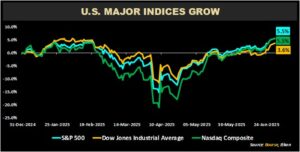
Folowing a relatively quiest start to the year, US equities endured a period of significant turbulence in March-April marked by a sharp decline across all three indices. Markets rebounded strongly in the following months. By the end of June, all three indices posted positive gains – the S&P 500 rose to 5.5%, followed by the Dow Jones at 3.6%, and the Nasdaq Composite at 5.5%. This volatility was brought on by potentially drastic changes to global trade policy – namely tariffs – and increasingly fragile geopolitical relations.
US sectors higher
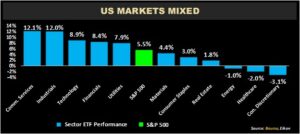
The S&P 500, the benchmark for U.S. equity markets, posted a 5.5% gain year-to-date, reflecting a solid performance in the first half of 2025. Notably, eight out of eleven sectors ended the period in positive territory, with standout performances from Communication Services and Industrials, both recording double-digit growth. The Communication Services Select Sector SPDR Fund (XLC) rose 12.1%, driven by strong earnings and increased AI-related demand for major platforms such as Alphabet and Meta. The Industrial Select Sector SPDR Fund (XLI) advanced 12.0%, supported by ongoing infrastructure investment and improved supply chain conditions. Gains were also seen in Technology (XLK) and Financials (XLF), which rose 8.9% and 8.4%, respectively. Meanwhile, the Utilities sector (XLU) climbed 7.9%, outperforming the broader market with investors favouring its defensive characteristics.
Tariffs, Conflicts Drive Markets
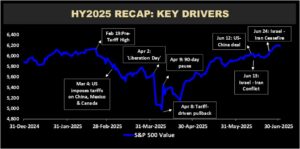
Markets in the first six months of 2025 were shaped by a complex interplay of shifting U.S. trade policies and geopolitical tensions. U.S. equities entered a sharp correction in early April, with the S&P 500 falling by more than 15% (S&P500: 4,983) after President Donald Trump announced sweeping new tariffs on April 2nd, referred to as “Liberation Day.” The measures included a 10% baseline tariff on all imports, alongside targeted tariffs of 25% on autos and 50% on steel and aluminum.
However, momentum shifted by late April as the Administration signalled a willingness to soften its position, leading to a temporary pause on some of the harsher measures. Negotiations resumed with key trading partners, particularly China. By June 12th, a preliminary U.S.–China trade agreement was reached, with both sides agreeing to lower reciprocal tariff rates to 10%, down from earlier peak levels. Despite this, cumulative U.S. tariffs on Chinese goods remain elevated at approximately 55%.
In early June, military tensions between Israel and Iran sparked a 12-day conflict, briefly driving oil prices up by 10%–15%. A fragile ceasefire was brokered on June 24th, leading to a quick de-escalation and a recovery in risk sentiment across markets. Overall, equity markets rebounded modestly into late June, buoyed by easing trade tensions.
Regional ETFs Higher
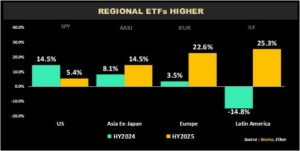
Overall, Regional Exchange Traded Funds (ETFs) posted strong positive returns in the first six months of 2025. Latin America (ILF) and Europe (IEUR) emerged as the top-performing regions, with gains of 25.3% and 22.6% respectively. Asia ex-Japan (AAXJ) also recorded solid growth increasing 14.5% as at HY2025. The U.S market (SPY) lagged its global peers, posting a more modest gain of 5.4% in HY2025, as tariff-driven volatility weighed on investor sentiment and limited market gains.
International Outlook
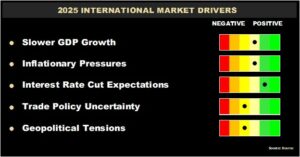
Consensus estimates now place the S&P 500 at 6,300 by year-end 2025, reflecting cautious optimism for continued earnings growth and market resilience. The target implies a modest 7.1% upside from December 2024 closing level of 5,882 and up 1.5% from June 30th closing level of 6,205. Looking forward to the second half of 2025, key drivers shaping U.S market sentiment and direction include:
- Slower GDP Growth – According to the World Bank, Global growth is now projected at 2.3% for 2025, nearly half a percentage point below earlier forecasts, amid trade tensions and policy uncertainty. The slowdown is led by weaker prospects in the U.S., where growth is now expected to ease to 1.4%, down from 1.8%. This marks the slowest pace of global expansion since 2008 outside of recessions, with nearly 60% of developing economies also set to decelerate, averaging 3.8% in 2025.
- Inflationary Pressures – The Bureau of Labor Statistics released U.S. inflation in May 2025 showing a slight uptick, with the annual headline rate rising to 2.4% (its first increase in four months). Core CPI, which excludes food and energy, rose 0.3% month-over-month, lifting the annual core inflation rate to 2.9% from 2.8%, remaining above the Federal Reserve’s 2% target. Data suggests that tariffs have not had a significant impact on inflation.
- Interest Rate Expectations – The Fed began easing interest rates in September 2024, bringing federal funds rate down to 4.25-4.50% range. Since then, it has maintained a cautious stance, holding rates steady at its latest June 2025 meeting. On July 1st, Fed Chair Jerome Powell signalled that a July rate cut remains on the table but would depend on incoming economic data. This marks a shift from his earlier stance, where he emphasized the need to evaluate the impact of tariffs on the U.S economy before making further policy moves. Markets are currently pricing in a 25-bps (0.25%) rate cut in September 2025, with expectations of two more cuts by year-end.
- Trade Policy Uncertainty – The 90-day pause on country- specific reciprocal tariffs will expire on July 9th, at which point the tariffs will automatically resume unless new agreements are reached. While the United Kingdom and China have secured deals, negotiations with other major trading partners including the European Union, Japan and India remain ongoing. If no agreements are finalized before the deadline, markets could potentially face renewed volatility as trade tensions escalate.
- Geopolitical Shifts – Geopolitical tensions are expected to remain a key source of uncertainty in the second half of 2025. Ongoing instability in the Middle East and conflicts in Eastern Europe pose risks to global trade, energy markets and supply chains. Any escalation may weigh on market sentiment and disrupt global financial markets.
Investor Considerations
Amid uncertainty about U.S. trade and monetary policy, global diversification has become increasingly important for investors seeking more balanced and resilient portfolios. Geographic diversification helps reduce portfolio risk by spreading investments across multiple markets, lowering exposure to country-specific economic or political shocks. Investors can consider ETFs which diversify by sector, country or even investment region (Asia, Latin America, US, Europe etc.).
For instance, the iShares MSCI ACWI ex U.S. ETF (ACWX), which tracks developed and emerging market stocks outside the U.S. advanced approximately 17% in the first half of 2025. This sharply outperformed the SPDR S&P 500 ETF (SPY), which gained just 5.4% over the same period, highlighting the potential benefits of diversifying international equity holdings.
Over a longer horizon, ACWX delivered a 3-year total return of 35.4% and a 5-year total return of 40.9%, while SPY posted stronger returns of 63.8% and 100.4% respectively. These figures reflect the dominance of U.S equities in recent years but also reinforce the case for geographic diversification. More involved investors can also build-in their preferred levels of diversification, using the wide array of ETFs available.
As always, investors are encouraged to consult a trusted investment adviser such as Bourse to make the most informed investment decisions.
This document has been prepared by Bourse Securities Limited, (“Bourse”), for information purposes only. The production of this publication is not to in any way establish an offer or solicit for the subscription, purchase or sale of any of the securities stated herein to US persons or to contradict any laws of jurisdictions which would interpret our research to be an offer. Any trade in securities recommended herein is done subject to the fact that Bourse, its subsidiaries and/or affiliates have or may have specific or potential conflicts of interest in respect of the security or the issuer of the security, including those arising from (i) trading or dealing in certain securities and acting as an investment advisor; (ii) holding of securities of the issuer as beneficial owner; (iii) having benefitted, benefitting or to benefit from compensation arrangements; (iv) acting as underwriter in any distribution of securities of the issuer in the three years immediately preceding this document; or (v) having direct or indirect financial or other interest in the security or the issuer of the security. Investors are advised accordingly. Neither Bourse nor any of its subsidiaries, affiliates directors, officers, employees, representatives or agents, accepts any liability whatsoever for any direct, indirect or consequential losses arising from the use of this document or its contents or reliance on the information contained herein. Bourse does not guarantee the accuracy or completeness of the information in this document, which may have been obtained from or is based upon trade and statistical services or other third-party sources. The information in this document is not intended to predict actual results and no assurances are given with respect thereto.”


